2020 Taebaek Mountain Hiking
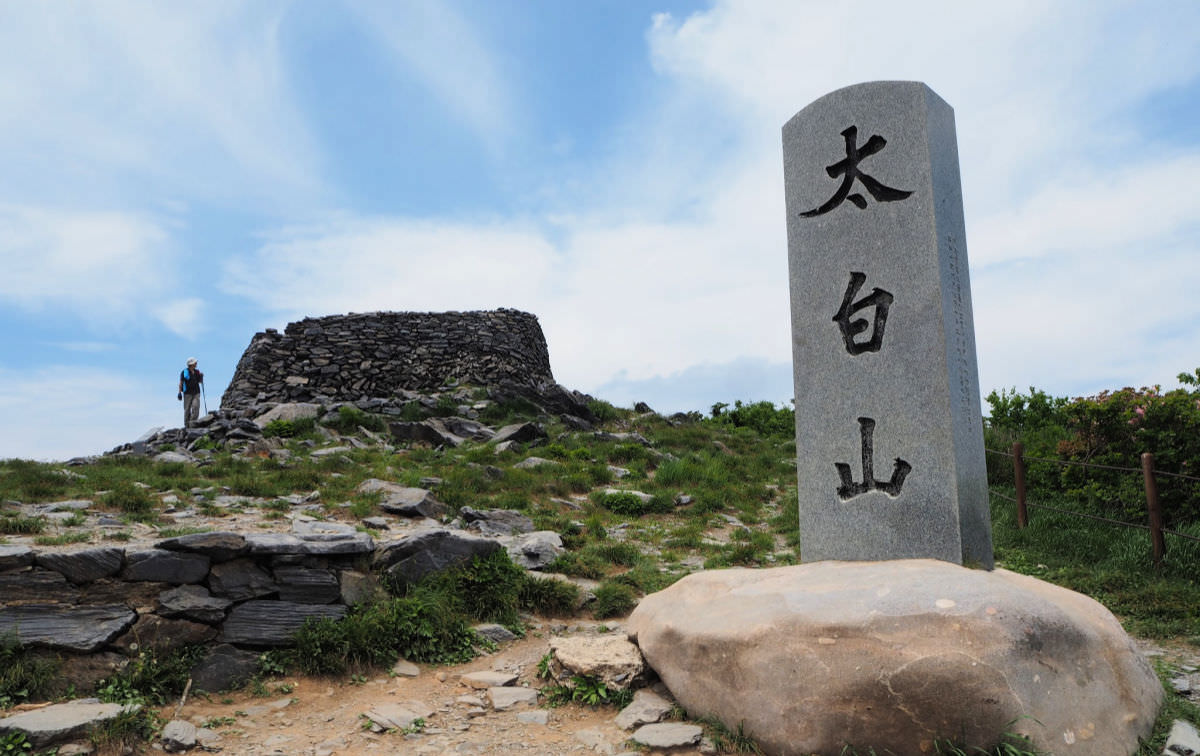 Cheonjaedan (Altar) and the granite stone carved with "taebaeksan" in Hanja on top of Taebaek Mountain National Park
Cheonjaedan (Altar) and the granite stone carved with "taebaeksan" in Hanja on top of Taebaek Mountain National ParkTaebaek Mountain Hiking
My Taebaek Mountain hiking is my second hike in a national park this year (2020). Due to the Covid-19 issues, I decided to visit this mountain, a national park, because it is closer to Seoul.
I am determined to hike all the South Korean national parks and provide quick guides to anyone interested. Hopefully, this experiential article will encourage you to explore Taebaek National Park or just a section of it.
The park authorities outline five main hiking courses (or trails), but you can combine a couple or three courses at once if you believe you can. Anyway, the course is recommended, but you can choose one or a combination of the trails as you see fit, just like I did.
Actually, I thought that I already made up my mind on the trail. But in my experience, I get better advice from taxi drivers who are locals and experienced hikers--most of them so far.
The taxi drivers were mostly hospital and kind enough to share their experiences and thoughts regarding the best trails to take. So, when I took the taxi, I started asking questions.
Here's our conversation (translated from Korean)...
Abbie (me): Annyonghasaeyo kisanim (hello, Mister!). Will you take me to the Yuilsa Entrance area?
Mr Kim (Driver): Yes, please get in!
Abbie: (Feeling grateful and excited) Thank you! I am going to hike Taebaek Mountain to reach Janggunbong (the highest peak of the Taebaek Mountain range).
Mr Kim: That's a great plan. After the Janggunbong Peak (literally, 'military general's peak'), you should also see Cheonjaedan (Altar). It is very close to Janggungbong, and you can even see it from there.
Abbie: Oh, that's a good idea. So, do you think it won't take long for me to complete the course (feeling worried!)?
Mr Kim: After exploring Cheonjaedan Altar, you can go down towards the Danggol Square area and return to the City via taxi. Just in case you cannot find a taxi, please let me know so that I can pick you up. If I am far from the area, I can send another cab to do it (then he kindly took out his wallet and handed me over his business card!).
Abbie: (Wow, feeling the superb hospitality!) Oh, really? It sounds like your suggestion is better than my plan!
To make the story short, I heeded his suggestion, which is better than the suggested one from the tour guide map!
I have seen many interesting sights and historical sites which I would have missed if I followed the guide map. The taxi driver's kind suggestion made my Taebaek Mountain hiking experience more fruitful than I thought.
Because of the revised hike plan, I was able to see the legendary places such as Cheonjaedan (ancient altar), Danggun Shrine (origin of Korean people), Coal Museum, King Danjong Shrine, temple areas, mountain gods stone statues, among others.
Don't worry! I will describe a bit more in detail the places and other great features of Taebaek Mountain as I continue recalling my experiences through this article.
Now, before I proceed, please let me describe a bit of Taebaek City, a small and cute city on the Taebaek Mountain range.
Taebaek City
Taebaek City is the highest city above sea level (650 to 700 meters) in
South Korea. It has a population of over 46 thousand, according to the
2015 census (Wikipedia).
The City is very clean and not crowded.
It has two main roads branching with streets with shops,
establishments, markets, cafes, and other smaller public and private
buildings.
The main attraction in Taebaek City is the legendary
Hwangji Pond Park. The park is impressive, beautiful, and serene. It has
public facilities (drinking water, toilets, etc.). It is at the heart
of this small City!
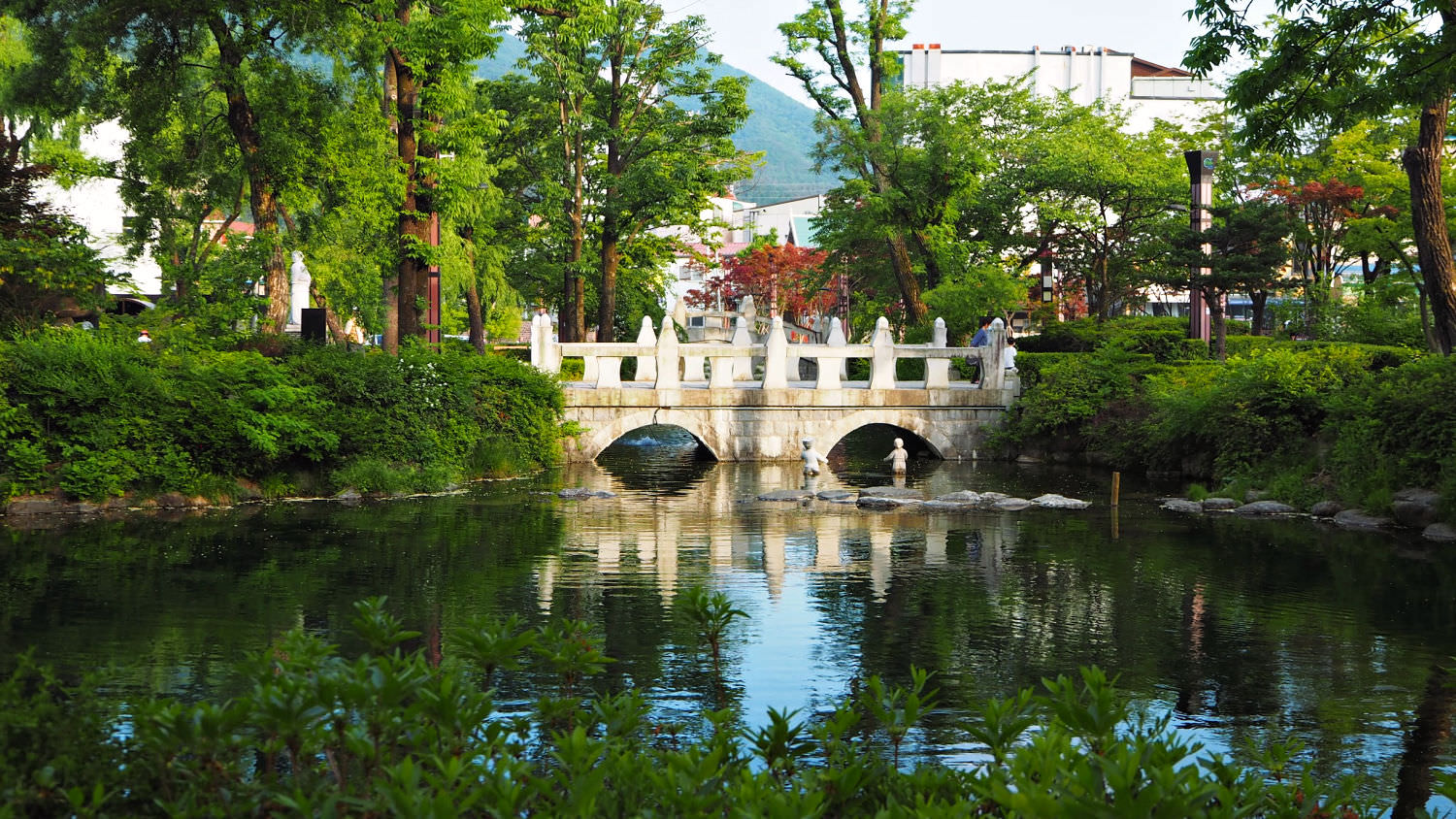 Taebaek City Hwangji Pond is a fantastic park and attraction in the heart of the city
Taebaek City Hwangji Pond is a fantastic park and attraction in the heart of the cityI just walk from Taebaek Inter-city Bus Terminal to my hotel, which only took around ten minutes. Yes, you can use your navigation apps in the area, and so don't worry about getting lost.
By the way, as you come out from the bus terminal, you will see a few meters ahead of you, the Tourism Guide building. I went there and picked up a map. Of course, you can do your research ahead, but having it in your hand could prove very useful and make your travel a lot easier to discover places.
The City itself is surrounded by mountains--gree mountains as it was early summer! They would all turn white during the Winter and colorful during the Autumn. The driver told me that more travelers come during the Spring and Winter seasons!
I think people prefer to see the Azaleas and other flowers during the Spring, and white and snowy mountains during the Winter!
My Taebaek Mountain Hiking Experience
My experience was an amazing and refreshing time for me. It provides me
some physical and psychological rejuvenation as a break from the routine
and demanding office works.
As mentioned above, I took a taxi
and decided to take the driver's advice to tread the trails he
mentioned. I asked him if he likes to hike to which he responded that he
is a member of a hiking club. Great, lucky me that I met the right
person to ask and receive helpful answers!
It took us around 15
minutes from the city center to the Yuilsa Entrance area. As soon as we
reached the Yuilsa Entrance Ticket Office, I thanked the driver. Then I
tightened my boots laces, belt, extended my hiking sticks! Whew!
It was tranquil! The road was roughly paved, and ahead it was covered with gravels. I thought they allow vehicles to climb up and down this part of the trail to let supplies be delivered to the temple area of Yuilsa Temple.
The road is quite steep but not difficult to climb. Trees, ferns, some flowers, birds, some squirrels were some of the flora and fauna representatives I have encountered along the way.
Although the temperature was almost 30 degrees centigrade that day, the verdant leaves of pine trees and cedars (and other tree species) provided me oxygen and cooler temperature.
I made a few stops until I reached the Yuilsa Temple area. I was surprised to see the cables and its structure in the resting area. Looking at it closely, I found that it is directly linked to Yuilsa Temple down below.
The cable (and a carrier), I believe, is being used to transport goods
in and out of the temple. That's because the temple, although only about
a 100 meters from the resting area, going down and climbing up is very
challenging--very steep!
Yes, there are nicely built ladders with
barristers. Despite that facility, I decided not to see the temple
below, thinking that it could drain out my energy and might stop me from
continuing my day's hike.
What I did was take photos from a
distance--right above the temple area! After having completed my hike
that day, I thought that I would visit that temple next time! Good
learning
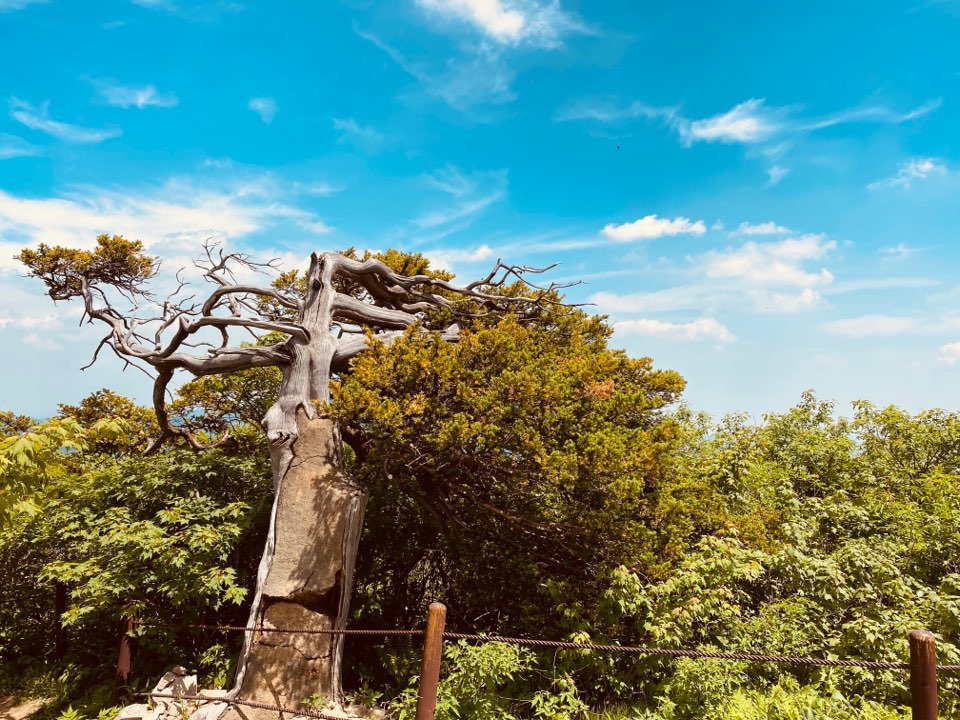 Yew Tree is one of the interesting sights on Taebaek Mountain aside from the panoramic mountain peaks and blue skies with white clouds
Yew Tree is one of the interesting sights on Taebaek Mountain aside from the panoramic mountain peaks and blue skies with white cloudsAncient Yew Trees
Having rested for a few minutes, taking a few shots, and sipped from my 1-liter backpack water camel, I started treading the rougher terrain amidst the forested and narrow trail.
Along the way, I saw various rock formations. Not only do the rock formations entertain me but also the trees that are growing on top and between rocks, which I thought impossible as there is no soil on them.
Such sights remind me, or I should say, showed me that nature is very resilient and can live in places or environments seemingly not possible for life. Honestly, it is helpful for introspection and meditation about life!
Yes, going back to Yew Trees...
I have seen many great photos of such trees. They look bare but exciting to look at! I know that the weather conditions on Taebaek Mountain are very harsh during the Winter season, but these trees are very resilient.
I found many such trees along the way as I proceed to climb toward the Janggundan Altar area--my ultimate destination being the highest peak of this mountain range.
Janggundan Altar
After passing through the labyrinth of trees
and trail, I finally reached Janggundan Altar. I know it is the one
because it is marked with a structure built with piled stones.
Janggundan
Altar was built as a memorial to a general long ago who used to observe
and pray on top of this mountain. Historians could not identify who the
general was but anyway established this structure to remind people
about one significant feature of this highest peak of Taebaek Mountain
National Park.
(description of the marker soon!)
I could see the Cheonjaedan Altar from the Janggundan Altar area, and the trail toward it flocked by Azaleas all the way.
Cheonjaedan Altar
Upon reaching Cheonjaedan Altar just around ten minutes from Janggudan, I noticed more hikers (less) and the area's space.
People
believed that Taebaek Mountain is the holiest among the mountains in
Korea, where the mountain gods live. The altar is on top of the
second-highest peak of this mountain range, after Janggundan Peak.
The
stone-piled altar structure is a round-shaped elevated alter, with one
entrance built with steps leading towards its middle part. I guess that
rituals are being held here during special events.
I noticed some hikers stopped for a moment and prayed while facing towards a specific direction for reasons I don't know!
It
is an excellent place to have a picnic, but you are not allowed to cook
anything in the area. Consuming your packed food and drinks are
allowed. Indeed, smoking is forbidden, and you could be severely fined
if caught (note that there's a CCTV installed in the area).
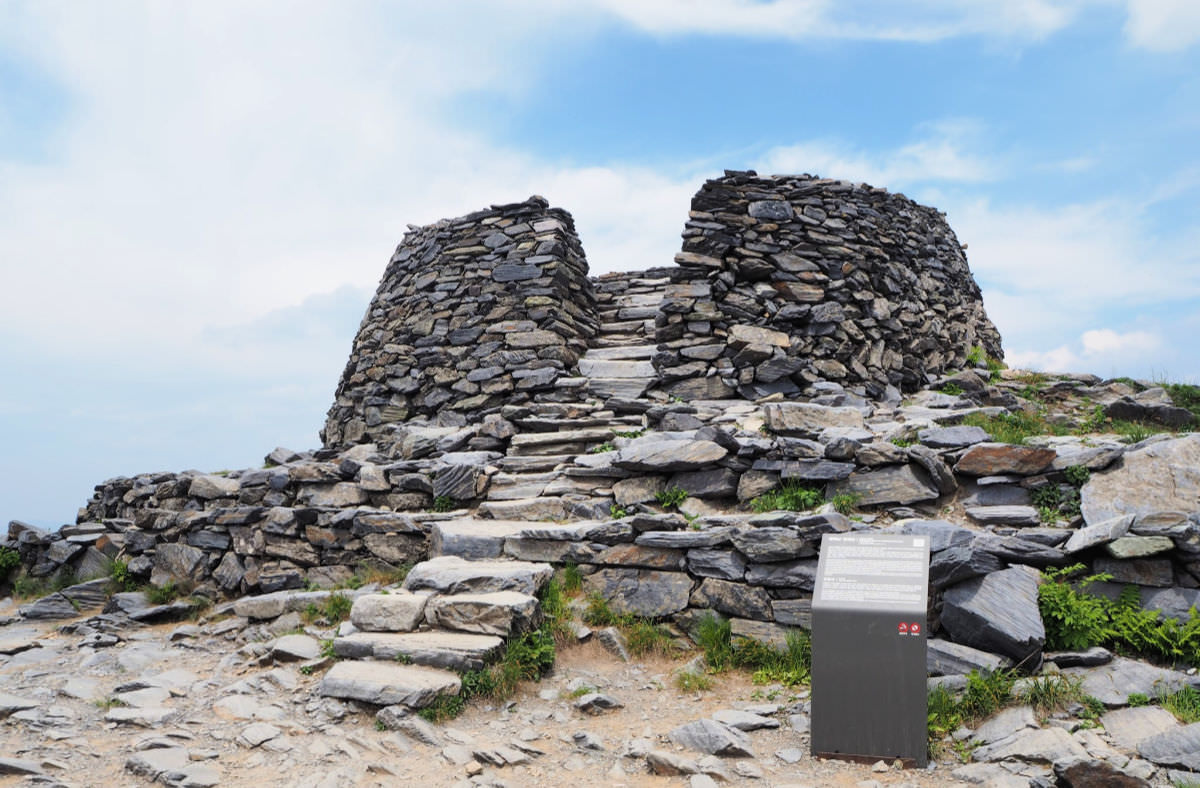 Cheonjaedan Altar on top of Taebaek Mountain
Cheonjaedan Altar on top of Taebaek MountainConscious about time, I checked the board map and wooden pole markers and then started to descend from the altar area.
Now,
it is not about pushing my weight up against gravity but carefully
putting my single steps in the right places. They say coming down from
the mountain could be harmful to one's knees, so be careful!
Then
I found a space with a temple-like structure. Having read the board
with descriptions and painting, I learned that this structure is a
memorial building...
King Danjong Monument (Danjong Bigak)
The
structure and place are for King Danjong, who once ruled the area. As
you can see, there is a structure that resembles to most temple
structures in Korea.
According to the description, the mayor of the area had a dream of encountering the late King Danjong.
The mayor's dream was so vivid that he decided to build a memorial to honor the king.
(Description of the dream)
Then I proceeded to hike down, enjoying the views, and greeting some hikers going up to where I came from.
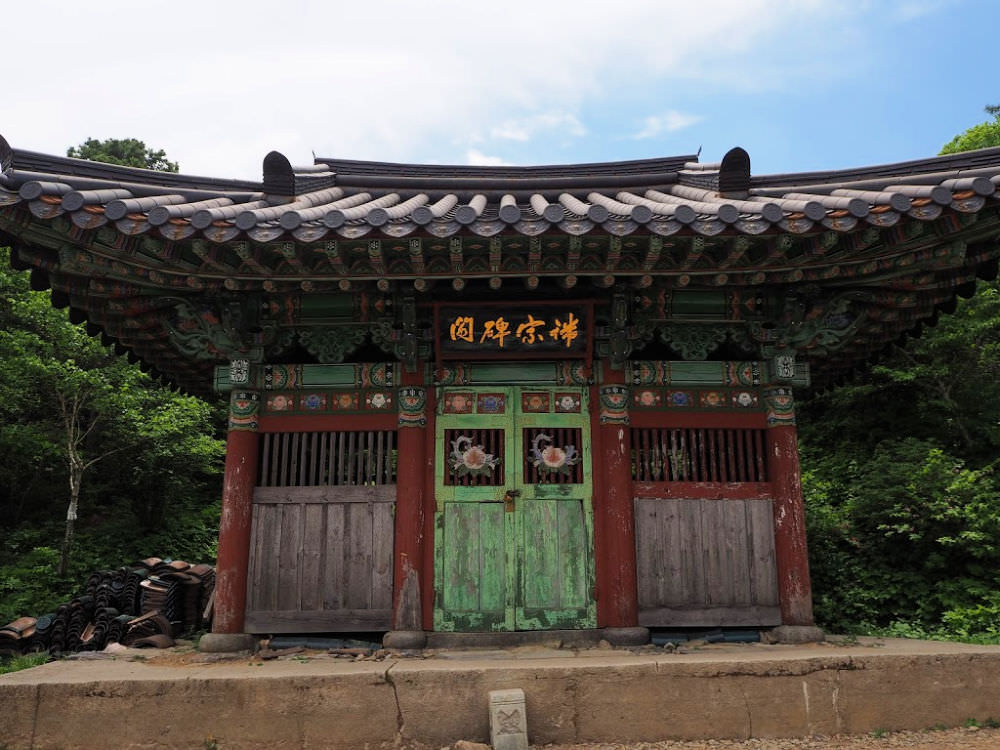 Danjong Bigak or King Danjong's Monument on the side of Taebaek Mountain
Danjong Bigak or King Danjong's Monument on the side of Taebaek MountainOne Temple Area
Temples always give me positive feelings and
impressions. This is probably because temples offer everyone a place to
think about life, goodness, to pray, and to meditate about anything.
I
dropped by this temple area, rested a while, and of course, took some
photos. I noticed that renovations and construction are ongoing, so I
decided only to explore the area quickly.
Just like in most
temple areas, there is a fountain for all visitors to drink from (yes,
for free). Some believed that temple fountains have sweeter water and
possess healing elements! What do you think? :)
Then I proceeded
and reached Banjae Hill, a resting area. From this area, I noticed that
the trail is not anymore narrow but like a road. As I went down further,
I could see the spacious Danggol Gwangjang (Square).
But before
heading directly to the square, I noticed a place with is described as
the Dangun Shrine. The name sounds familiar, and so I peeked in and
decided to investigate further.
Dangun Shrine
In the square of Dangun Shrine, I saw a statue (photo). It should be a statue of Dangun. Dangun, according to the Korea legend, was the originator of the first Korean of the present Korean people.
This very mountain is the birthplace of the Korean people. So, this shrine is dedicated to the belief as handed down from the stories told by the early Korean people.
The shrine seems to be well-maintained, and there is a house where the custodians live and manage the shrine.
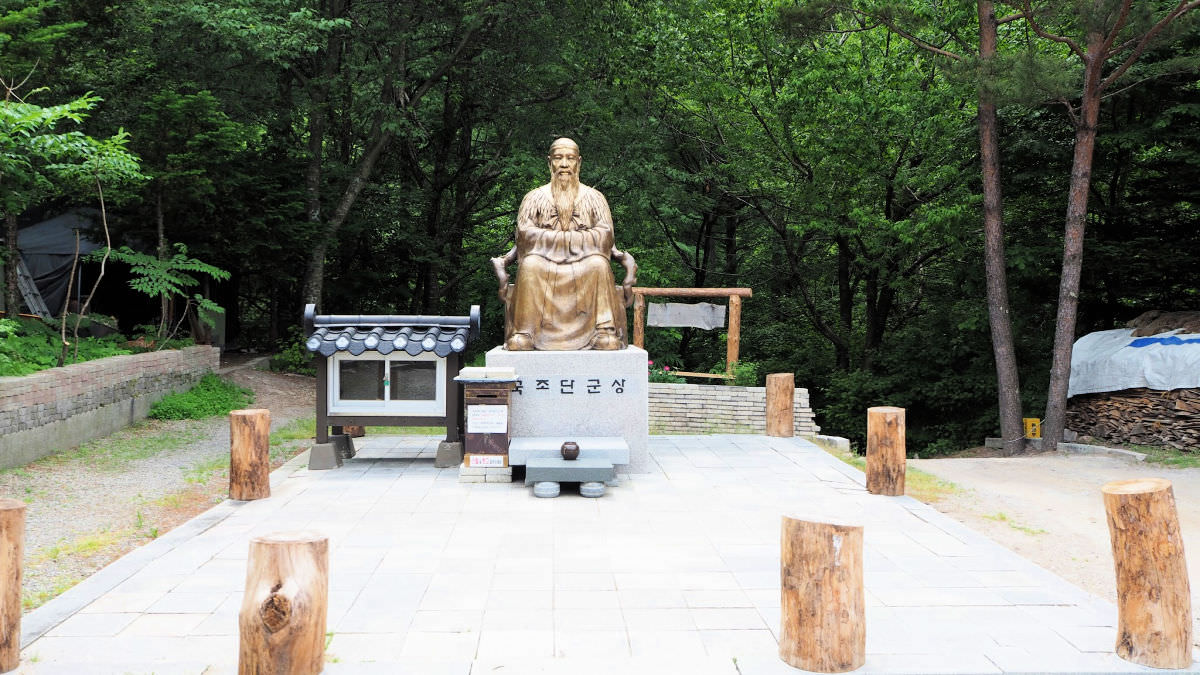 Statue of Dangun (legendary origin of the Korean people) in Taebaek Mountain National Park
Statue of Dangun (legendary origin of the Korean people) in Taebaek Mountain National Park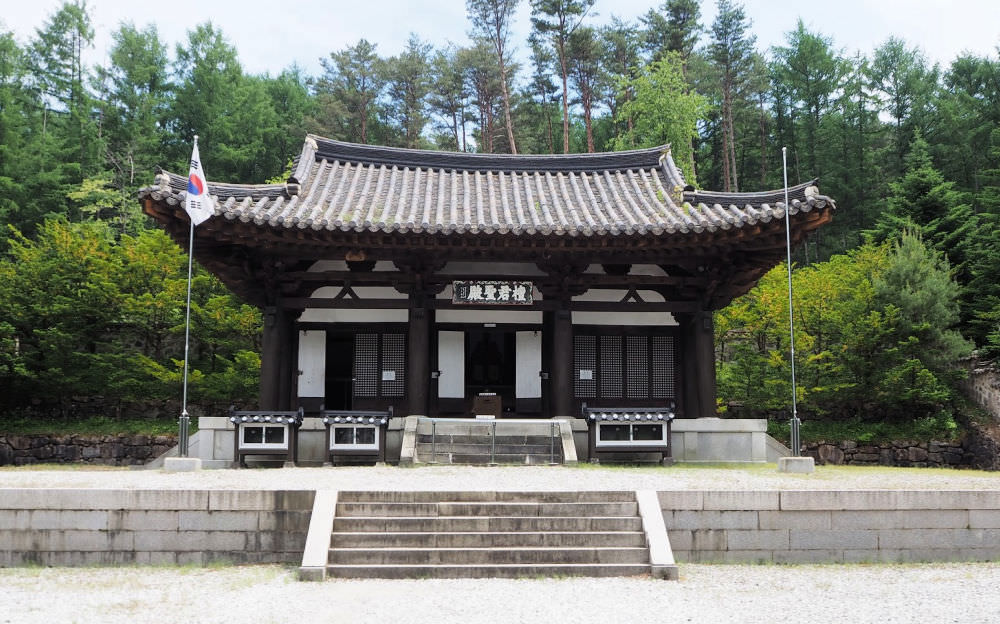 Monument for Dangun
Monument for DangunTwo Mountain Gods
After my quick visit to the Dangun Shrine, I proceeded below feeling relieved and assured that I made it!
Still,
I found these two old stones (granite). I read the descriptions beside
it and learned that they were mountain gods (sansin). One is male and
the other female.
They looked defaced for some reason. Probably due to extreme elements and passage of time.!
Danggul Gwangjang (Square)
Here I come! This is my final
destination, and I succeeded. Here, you will find a parking space for
private vehicles with limited space. The middle part of the square is
empty.
On its right side, as you face the mountain, you can find
the stage with a cover. I am guessing that this space is reserved for
special events and activities during specific dates.
You can find
facilities including washrooms, cafes, a convenience store, and a
restaurant, among others. Lo, I found another or one last thing...
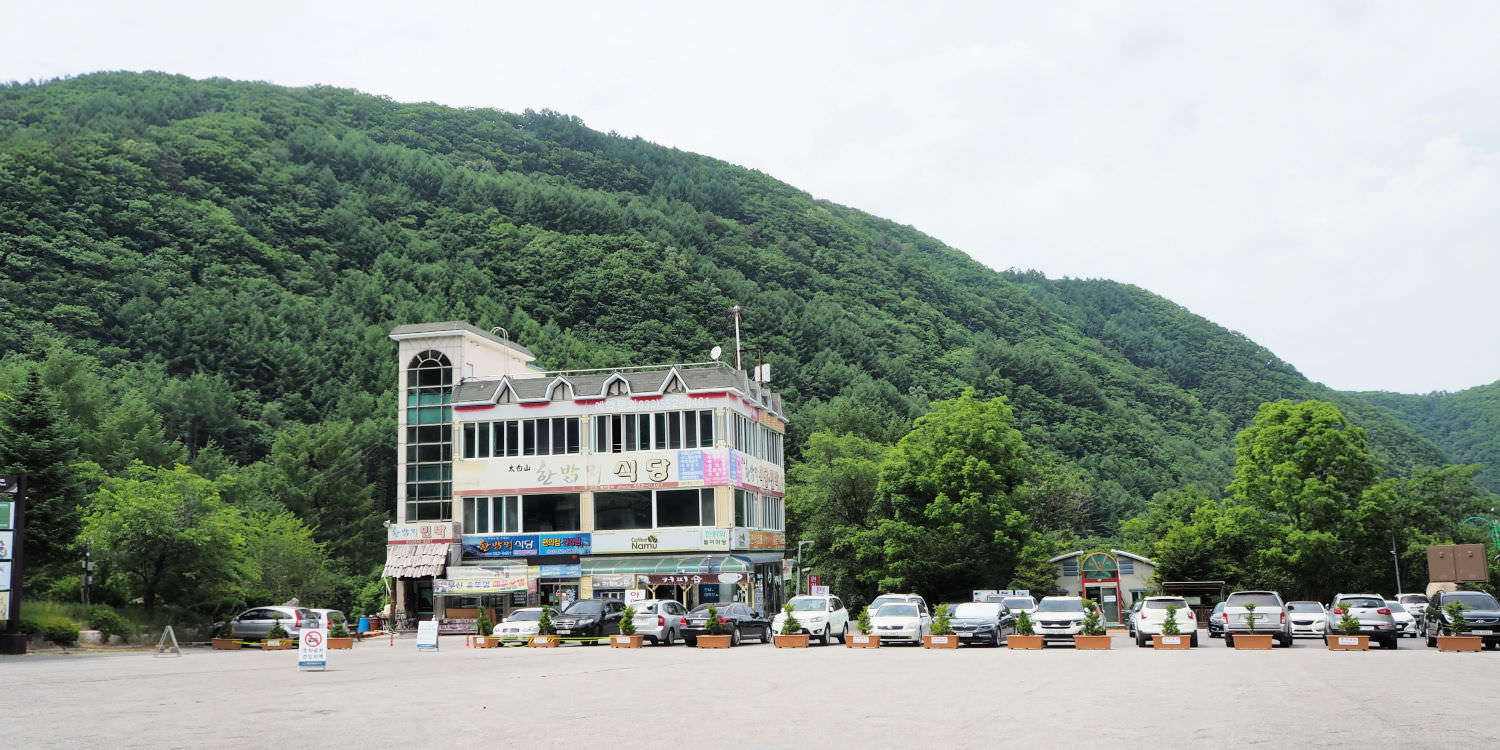 Dangul Square (Gwangjang) is where small cars can park and events being held seasonally
Dangul Square (Gwangjang) is where small cars can park and events being held seasonallyCoal Museum
Visiting this museum was not part of my original plan. After quickly checking it out, I thought it is worth my time.
So,
here I went. I paid 2,000 Won (around 2.40 USD). I had my temperature
checked and rubbed my hands with the disinfectant (to prevent people
with signs of Covid-19 from getting inside the museum).
This
museum basically displays samples of coals extracted in the mountains of
Taebaek. For your information, the Taebaek area is one of the leading
producers of coal, but most of its mines were closed down except for the
remaining three (according to the taxi driver as of this writing).
Other
exciting displays that I really enjoyed are the samples of metals
(iron, etc.), elements (pyrite, sulfur, etc.), jewels (ruby, etc.),
dinosaur eggs, bones, fossils (tree trunks, fish, seashells, tree
leaves, etc.).
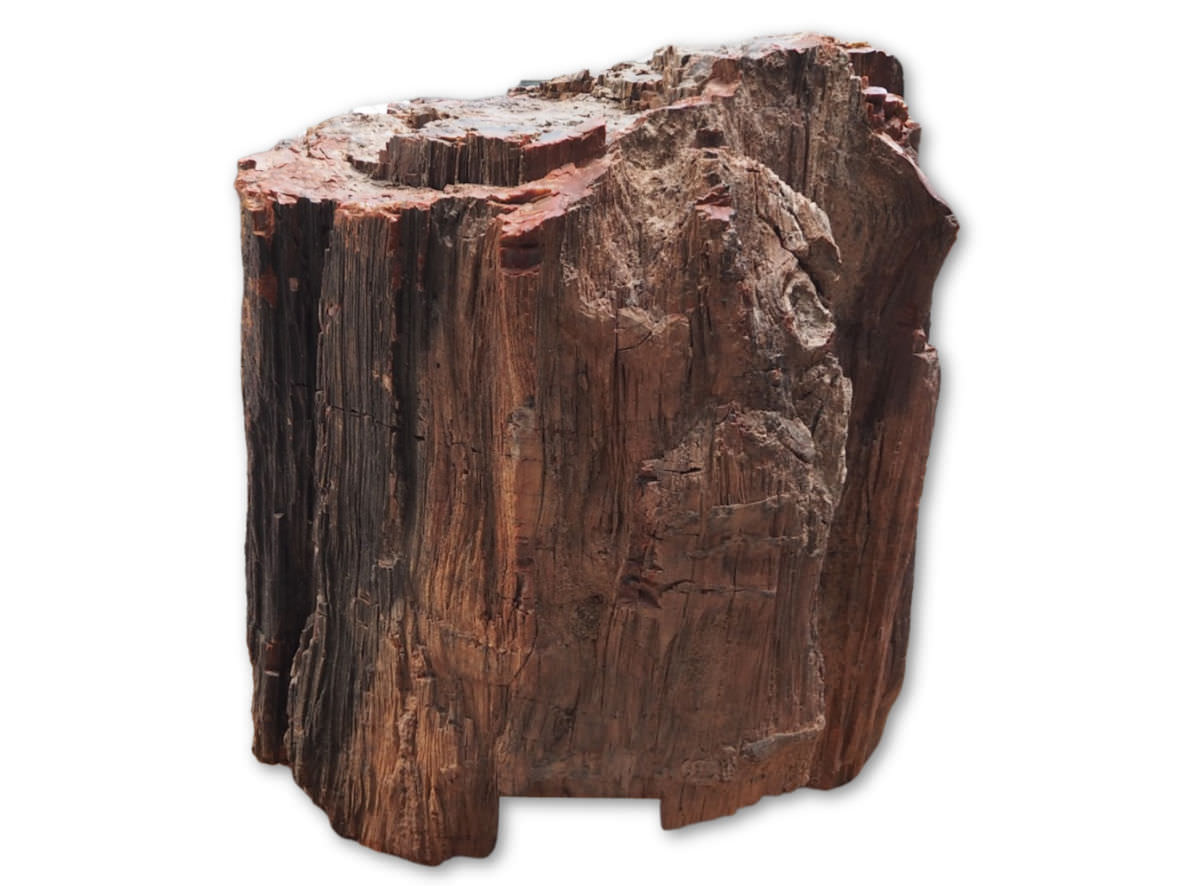 Part of a petrified (fossilized) tree trunk at the museum
Part of a petrified (fossilized) tree trunk at the museumIn one of the exhibition rooms, you will see how the mining methods and usage of coal have developed, such as the extraction using crude picks and hammers into drilling machines.
Then, the last exhibition part of the museum is the underground mining experience area. I took the elevator to get there. It's a bit scary as in real-life mining areas.
The have simulation areas on how coals are extracted, how miners work, and eat underground. One area got me shocked as the logs started to break and collapsed. It's part of the simulated event which happened in real life among miners.
Parking Area
The parking area is located just right a few meters down below the Taebaek Coal Museum.
This area accommodates tour buses, cars, and has a taxi waiting area, where I took the taxi back to the City. Again, I was grateful that the driver was very hospitable and told me stories and facts about Taebaek City.
The driver said that the City used to be covered with black dust coming from the coals. He said that they used to have around a hundred coal mining areas. Now, only three are under operation.
I told him my direction, assuming that he didn't know my hotel. When I mentioned when I was staying, he responded he knew it. Do you know all the hotels here? I asked. To which he answered that they could be counted with his fingers (literal translation).
Staying in Taebaek City
As a travel destination, Taebaek City offers various kinds of lodging. There are hotels, motels, villas, B&B, homestays.
I
booked my hotel online to make sure I have a place to stay. As an
affiliate to an international hotel booking company, you can be assured
that the hotel you booked has satisfied international standards, such as
cleanliness, service, and accessibility.
For more places to stay, you may search for your accommodation here.
More Taebaek Attractions
The following are the main attractions that any traveler can explore and enjoy within and nearby Taebaek City and Taebaek National Park and surrounding areas.
Alpine Coaster Attractions
Chuam Chotdaebawi Rock
Cheonjaedan Altar
Cheonggok Cave
Daegwallyong Sheep Farm
DongHai Attraction
Echo Green Campus
Geomnyongso Pond
Gyeongpo Beach
Gyeongpodae
Haslla Art World
Hwanseongul Cave
Hwangji Pond
High1 Resort
Hourglass Park
Hwaam Cave
Jangho Port
Jeongdongjin-ri
Janggunbong Peak
Jukseoru Pavilion
Ocean Rail Bike
Ojukheon Attraction
Samhwasa Temple
Seatrain Attraction
Skywalk Attraction
Sunrise Peak
Taebaek Coal Museum
Taebaek National Park
Yongpyong Resort Ski & Snowboard
Yuilsa Temple area
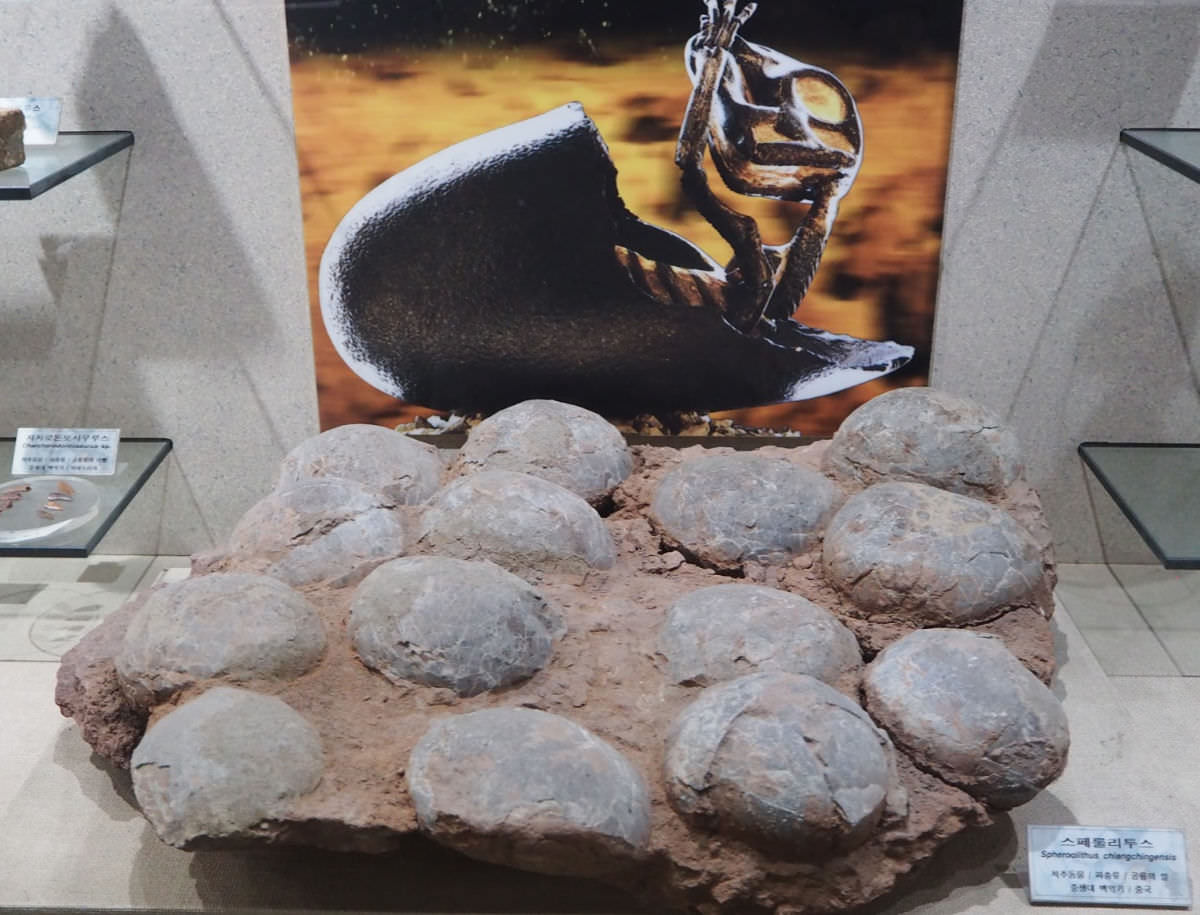 Fossilized dinosaur eggs on display at Taebaek Coal Museum
Fossilized dinosaur eggs on display at Taebaek Coal MuseumTaebaek Mountain Hiking Directions
You can get to Taebaek City via train, inter-city bus, or cars (including a taxi). From Seoul, travel is around three hours or so by bus or train. It should be shorter by private or rented cars.
Train From Seoul
Take a train from Cheongnyangri Station for Taebaek City. The first train leaves at 7 AM, and the last one is 11:20 PM. Travel time is 3 hours and 50 minutes. The train operates six times daily only.
Other trains for Taebaek are from Jeongdongjin, Dong Daegu, and Bujeon.
Inter-City Bus
From Seoul, take the bus at Dong Seoul Bus Terminal, which will take 3 hours or so. The first one leaves at 6 AM, and the last one is at 11 PM.
Other bus stations for Taebaek are in Buk Daegu, Wonju, Gangneung, and Busan City.
Get Exciting Activities
Book one of our exciting activities today to experience the thrill of a lifetime! Take advantage of this opportunity and secure your spot in advance.
Hotel Map Guide
Find your affordable, accessible, and comfortable hotel in Seoul at Agoda.Com. See the hotel map below...
Hotel Booking Guide
Find affordable and amazing hotels on Agoda.com using the search box below. Book now to enjoy great discounts and save!




New! Comments
What do you think about this page? Leave me a comment in the box below.